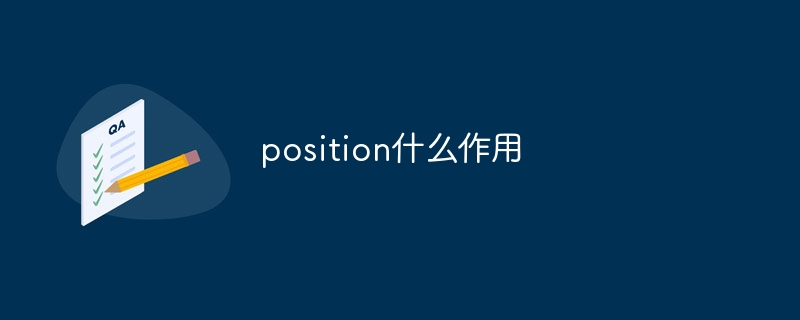Home >Web Front-end >Front-end Q&A >What does position do?
What does position do?
- 百草Original
- 2023-10-09 13:33:481481browse
Position can be used in scenarios such as web page layout, animation effects, map applications, and game development. Detailed introduction: 1. Web page layout, in HTML and CSS, you can use the position attribute to control the positioning of elements in the web page. Common position attribute values are static, relative, absolute and fixed; 2. Animation effects, in JavaScript, You can use the position attribute to change the position of the element to achieve animation effects and more.

The operating system for this tutorial: Windows 10 system, DELL G3 computer.
Position plays a very important role in program development. It is a concept for locating elements or data and can be used in a variety of different scenarios and needs. In this article, I will detail the role of position and its application in different programming languages and frameworks.
First of all, position can be used for web page layout. In HTML and CSS, we can use the position attribute to control the positioning of elements in the web page. Common position attribute values include static, relative, absolute and fixed. static is the default value, and elements are laid out in the order of the document flow. Relative will position the element relative to its original position without affecting the layout of other elements. Absolute will be positioned relative to the nearest non-statically positioned parent element, or relative to the body element if none is found. fixed will be positioned relative to the browser window, and the element will be fixed at a certain position on the page and will not move with scrolling. By using these position attribute values, we can achieve various complex web page layout effects.
Secondly, position can also be used to achieve animation effects. In JavaScript, we can use the position attribute to change the position of an element to achieve animation effects. By changing the element's top, left, right, and bottom properties, we can make the element move, scale, or rotate on the page. By changing the position of elements, various animation effects can be created to make web pages more vivid and interesting.
In addition, position can also be used for positioning in map applications. In a map application, we can use the position attribute to obtain the user's geographical location information. Through the browser's Geolocation API, we can obtain the user's latitude and longitude coordinates to implement the positioning function. This way we can mark the user's location on a map or calculate the distance between the user and other locations.
In addition, position can also be used for collision detection in game development. In the game, we need to detect whether a collision occurs between game characters or objects in order to handle it accordingly. By getting the position attribute of the element, we can get the position and size information of the element to determine whether it collides with other elements. In this way, we can implement the collision detection function in the game and improve the realism and playability of the game.
To sum up, position has a wide range of applications in program development. It can be used in different scenarios such as web page layout, animation effects, map applications and game development. By rationally using the position attribute, we can achieve a variety of functions and effects and improve the interactivity and user experience of the program. Therefore, it is very important for programmers to master and understand the role of position.
The above is the detailed content of What does position do?. For more information, please follow other related articles on the PHP Chinese website!

